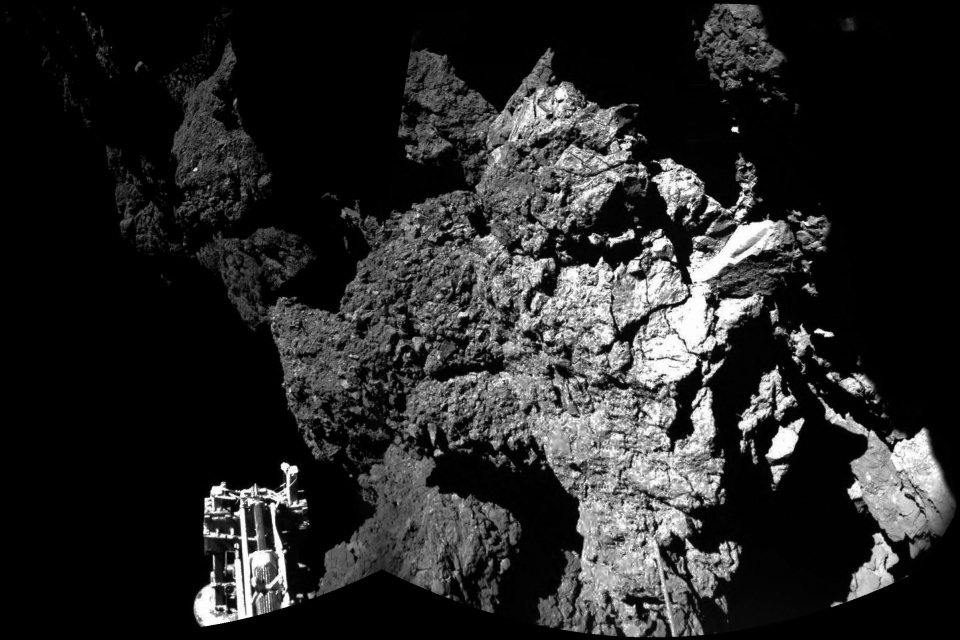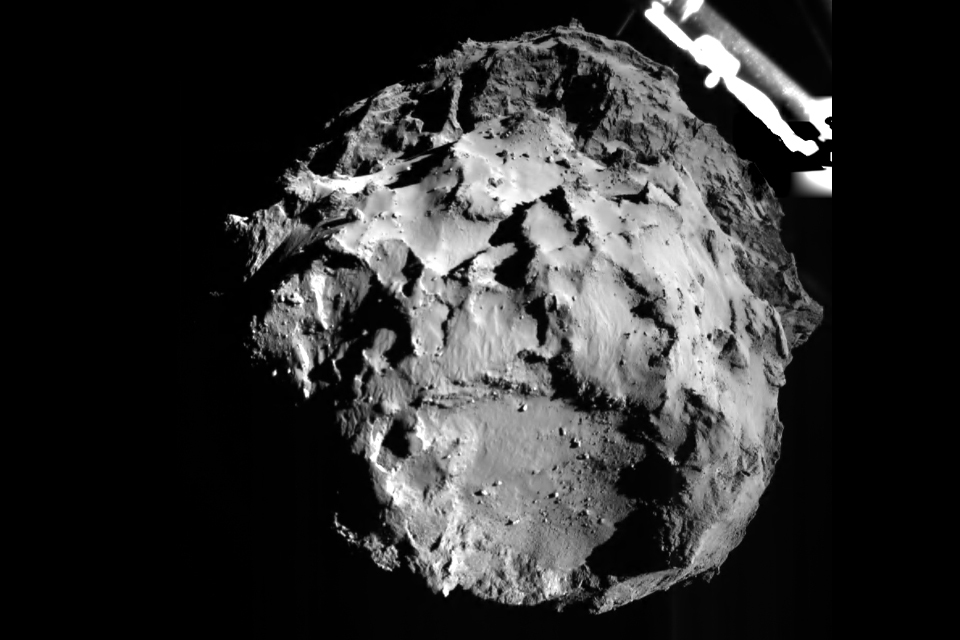Europe makes history with first ever comet landing
Successful touchdown for Rosetta’s Philae lander.

Artist's impression of Philae. Credit: ESA.

Comet surface pictured by CIVA instrument on Philae lander.
The UK Space Agency and UK scientists involved in Europe’s Rosetta mission are celebrating as the mission’s Philae lander has today (12 November 2014) made the first ever landing on a comet, opening a new chapter in Solar System exploration.
Following separation from the Rosetta orbiter at 08:35 GMT this morning, Philae touched down on comet 67P at around 16:03 GMT. There were cheers and hugs at the control room in Darmstadt, Germany after the signal was confirmed.
Universities, Science and Cities Minister Greg Clark said:
This truly is a momentous day. The Rosetta mission is once again making history, this time by deploying a lander on the surface of the comet. We cannot underestimate just how much of a challenge and technical feat this has been to achieve. UK scientists, engineers and industry have played a central role in its success and will inspire a generation of children to become involved in science.
We look forward to the discoveries the Philae lander will make as it carries out its multiple experiments in the weeks and months to come.

The image shows comet 67P/CG acquired by the ROLIS instrument on the Philae lander during descent on Nov 12, 2014 14:38:41 UT from a distance of approximately 3 km from the surface. The landing site is imaged with a resolution of about 3m per pixel.
Ian Wright, Professor of Planetary Sciences at the Open University and Principal Investigator for the Ptolemy instrument, added:
Ptolemy represents British ingenuity at its best. The instrument was born out of a creative milieu that saw scientific enquiry meld with engineering capability to satisfy a burning desire to venture into the unknown. Landing on a comet is a first for space exploration. Our hope is that within a very short while we will have scientific data that not only helps to address some of the questions we set out to investigate, but which also justifies the long-term vision of UK funding agencies, as well as the support and encouragement from the two organisations that worked together to make the dream a reality - namely, the Open University and STFC RAL Space.
Comets are considered to be primitive building blocks of the Solar System and may have helped to ‘seed’ Earth with water, perhaps even the ingredients for life. But many fundamental questions about these enigmatic objects remain, and through a comprehensive, in situ study of the comet, Philae aims to unlock the secrets within. The lander’s UK-led Ptolemy instrument will play an important role in Philae’s discoveries as it performs on-the-spot analysis of the composition of the ices and organic material within the comet.
Rosetta and the UK
With funding from the UK Space Agency and the Science and Technology Facilities Council (STFC), Rosetta is a mission with significant UK involvement from industry and science.
One of the main challenges for all the companies designing instruments for Rosetta has been to ensure the components remain intact for ten years, while the spacecraft makes its way to the comet, and then work perfectly when it gets there. Not an easy task!
Industry involvement
- Airbus Defence and Space, based in Stevenage, was the major subcontractor for the Rosetta platform.
- e2v, based in Chelmsford, designed and supplied the high performance imaging devices used in the Navigation Camera, OSIRIS narrow field and wide field cameras and VITRIS-M instruments on the orbiter and ROLIS and CIVA instruments on the lander
- ABSL Space Products provided innovative batteries for the spacecraft and lander. These are smaller, lighter and much more reliable than the traditional nickel-cadmium batteries.
- ERS Technology supported the development of many subsystems including the reactions wheels, solar array drive motors, Philae harpoon motors and developed the lubricant for the atomic force microscope on the Micro-Imaging Dust Analysis System (MIDAS).
- Technology created by CGI Group helped to explore some of the issues involved in such a long mission. The company was also involved in the development of the Rosetta on board software.
- Moog provided tanks to store the helium used by the lander.
- STFC’s RAL Space co-developed the Ptolemy instrument with the Open University and designed the thermal insulation for the GIADA and VIRTIS instruments as well as the Philae lander itself.
- SciSys UK Ltd is responsible for the spacecraft Mission Control System development and maintenance. In recognition of this work on the Rosetta and the Beagle 2 missions, SciSys were awarded the title of “Innovator of the Year” by the UK Computing Awards for Excellence 2004.
- Surrey Satellite Technology Limited (SSTL) designed a wheel that will stabilise the probe as it descends and lands on the comet.
- Telespazio VEGA was involved in many aspects of the Rosetta mission, from the overall design of the spacecraft to the on-board software.
Science involvement
UK scientists are involved in ten of the 21 experiments that Rosetta will carry out during its mission:
- The Open University in collaboration with STFC RAL Space designed and built the Ptolemy instrument on the lander and is contributing scientific expertise to the GIADA, MUPUS and SESAME instrument teams
- The University of Kent will be helping to analyse the results from the OSIRIS instrument and have been involved in observing Rosetta’s target comet from ground-based telescopes to aid mission planning
- Imperial College London and University College London’s Mullard Space Science Laboratory (MSSL) supply the team studying the comet’s plasma.
- Scientists at Oxford University are part of the science team for VIRTIS.
- Queen Mary College at the University of London will be investigating the results of the CONSERT instrument.
- Researchers from Queen’s University Belfast are part of the team observing Rosetta’s target comet using ground-based telescopes.